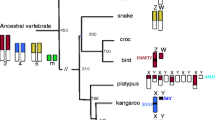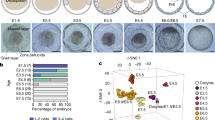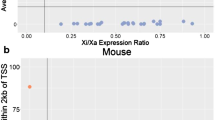Abstract
X-chromosome inactivation (XCI) evolved in mammals to deal with X-chromosome dosage imbalance between the XX female and the XY male. In eutherian mammals, random XCI of the soma requires a master regulatory locus known as the ‘X-inactivation center’(XIC/Xic), wherein lies the noncoding XIST/Xist silencer RNA and its regulatory antisense Tsix gene. By contrast, marsupial XCI is imprinted to occur on the paternal X chromosome. To determine whether marsupials and eutherians share the XIC-driven mechanism, we search for the sequence equivalents in the genome of the South American opossum, Monodelphis domestica. Positional cloning and bioinformatic analysis reveal several interesting findings. First, protein-coding genes that flank the eutherian XIC are well-conserved in M. domestica, as well as in chicken, frog, and pufferfish. However, in M. domestica we fail to identify any recognizable XIST or TSIX equivalents. Moreover, cytogenetic mapping shows a surprising break in synteny with eutherian mammals and other vertebrates. Therefore, during the evolution of the marsupial X chromosome, one or more rearrangements broke up an otherwise evolutionarily conserved block of vertebrate genes. The failure to find XIST/TSIX in M. domestica may suggest that the ancestral XIC is too divergent to allow for detection by current methods. Alternatively, the XIC may have arisen relatively late in mammalian evolution, possibly in eutherians with the emergence of random XCI. The latter argues that marsupial XCI does not require XIST and opens the search for alternative mechanisms of dosage compensation.
Similar content being viewed by others
References
Borsani G, Tonlorenzi R, Simmler MC et al. (1991) Characterization of a murine gene expressed from the inactive X chromosome. Nature 351: 325-29.
Brockdorff N, Ashworth A, Kay GF et al. (1991) Conservation of position and exclusive expression of mouse Xist from the inactive X chromosome. Nature 351: 329-31.
Brown CJ, Ballabio A, Rupert JL et al. (1991) A gene from the region of the human X inactivation centre is expressed exclusively from the inactive X chromosome. Nature 349: 38-4.
Charlesworth B (1978) Model for evolution of Y chromosomes and dosage compensation. Proc Natl Acad Sci USA 75: 5613-622.
Charlesworth B (1991) The evolution of sex chromosomes. Science 251: 1030-033.
Chureau C, Prissette M, Bourdet A et al. (2002) Comparative sequence analysis of the X-inactivation center region in mouse, human, and bovine. Genome Res 12: 894-08.
Clemson CM, Chow JC, Brown CJ, Lawrence JB (1998) Stabilization and localization of Xist RNA are controlled by separate mechanisms and are not sufficient for X inactivation. J Cell Biol 142: 13-3.
Cohen DE, Davidow LS, Erwin JA, Xu N, Warshawsky D, Lee JT (2007) The DXPas34 repeat regulates random and imprinted X inactivation. Develop Cell 12: 57-1.
Cooper DW (1971) Directed genetic change model for X chromosome inactivation in eutherian mammals. Nature 230: 292-94.
Duke S, Samollow P, Mauceli E, Lindblad-Toh K, Breen M (2007) Integrated cytogenetic BAC map of the genome of the gray short-tailed opossum, Monodelphis domestica. Chromosome Res (Submitted).
Duret L, Chureau C, Samain S, Weissenbach J, Avner P (2006) The Xist RNA gene evolved in eutherians by pseudogenization of a protein-coding gene. Science 312: 1653-655.
Glazko GV, Koonin EV, Rogozin IB (2005) Molecular dating: ape bones agree with chicken entrails. Trends Genet 21: 89-2.
Graves JAM (1996) Mammals that break the rules: genetics of marsupials and monotremes. Annu Rev Genet 30: 233-60.
Greaves IK, Rangasamy D, Devoy M, Marshall Graves JA, Tremethick DJ (2006) The X and Y chromosomes assemble into H2A.Z-containing [corrected] facultative heterochromatin [corrected] following meiosis. Mol Cell Biol 26: 5394-405.
Grutzner F, Rens W, Tsend-Ayush E et al. (2004) In the platypus a meiotic chain of ten sex chromosomes shares genes with the bird Z and mammal X chromosomes. Nature 432: 913-17.
Huynh KD, Lee JT (2001) Imprinted X inactivation in eutherians: a model of gametic execution and zygotic relaxation. Curr Op Cell Biol 13: 690-97.
Huynh KD, Lee JT (2003) Inheritance of a pre-inactivated paternal X-chromosome in early mouse embryos. Nature 426: 857-62.
Huynh KD, Lee JT (2005) X-chromosome inactivation: linking ontogeny and phylogeny. Nat Rev Genet 6: 410-18.
Johnston C, Newall A, Brockdorff N, Nesterova T (2002) Enox, a novel gene that maps 10 kb upstream of Xist and partially escapes X inactivation. Genomics 80: 236.
Koina E, Wakefield MJ, Walcher C et al. (2005) Isolation, X location and activity of the marsupial homologue of SLC16A2, an XIST-flanking gene in eutherian mammals. Chromosome Res 13: 687-98.
Kumar S, Hedges SB (1998) A molecular timescale for vertebrate evolution. Nature 392: 917-20.
Lee JT (2000) Disruption of imprinted X inactivation by parent-of-origin effects at Tsix. Cell 103: 17-7.
Lee JT (2002) Homozygous Tsix mutant mice reveal a sex-ratio distortion and revert to random X-inactivation. Nature Genet 32: 195-00.
Lee JT (2005) Regulation of X-chromosome counting by Tsix and Xite sequences. Science 309: 768-71.
Lee JT, Lu N (1999) Targeted mutagenesis of Tsix leads to nonrandom X-inactivation. Cell 99: 47-7.
Lee MS (1999) Molecular clock calibrations and metazoan divergence dates. J Mol Evol 49: 385-91.
Lifschytz E, Lindsley DL (1972) The role of X-chromosome inactivation during spermatogenesis. Proc Natl Acad Sci USA 69: 182-86.
Lucchesi JC, Kelly WG, Panning B (2005) Chromatin remodeling in dosage compensation. Annu Rev Genet 39: 615-51.
Lyon MF (1961) Gene action in the X-chromosome of the mouse (Mus musculus L.). Nature 190: 372-73.
Lyon MF (1999) Imprinting and X chromosome inactivation. In Ohlsson R, ed., Results and Problems in Cell Differentiation. Heidelberg: Springer-Verlag, pp. 73–90.
Mak W, Nesterova TB, de Napoles M et al. (2004) Reactivation of the paternal X chromosome in early mouse embryos. Science 303: 633-34.
McCarrey JR (2001) X-chromosome inactivation during spermatogenesis: the orginal dosage compensation mechanism in mammals? In Xue YXG, Xu Z, Holmes R, Hammond GL, Lim HA, eds., Gene Families: Studies of DNA, RNA, Enzymes and Proteins. New Jersey: World Scientific Publishing Co., pp. 59–72.
McCarrey JR, Watson C, Atencio J et al. (2002) X-chromosome inactivation during spermatogenesis is regulated by an Xist/Tsix-independent mechanism in the mouse. Genesis 34: 257-66.
Namekawa SH, Park PJ, Zhang LF et al. (2006) Postmeiotic sex chromatin in the male germline of mice. Curr Biol 16: 660-67.
Ogawa Y, Lee JT (2003) Xite, X-inactivation intergenic transcription elements that regulate the probability of choice. Mol Cell 11: 731-43.
Okamoto I, Otte AP, Allis CD, Reinberg D, Heard E (2004) Epigenetic dynamics of imprinted X inactivation during early mouse development. Science 303: 633-44.
Plath K, Mlynarczyk-Evans SK, Nusinow DA, Panning B (2002) Xist RNA and the mechanism of X chromosome inactivation. Annu Rev Genet 36: 233-78.
Sado T, Wang Z, Sasaki H, Li E (2001) Regulation of imprinted X-chromosome inactivation in mice by Tsix. Development 128: 1275-286.
Sharman GB (1971) Late DNA replication in the paternally derived X chromosome of female kangaroos. Nature 230: 231-32.
Simmler M-C, Cunningham DB, Clerc P et al. (1996) A 94 kb genomic sequence 3′ to the murine Xist gene reveals an AT rich region containing a new testis specific gene Tsx. Human Mol Genet 5: 1713-726.
Solari AJ (1974) The behavior of the XY pair in mammals. Int Rev Cytol 38: 273-17.
Takagi N, Sasaki M (1975) Preferential inactivation of the paternally derived X-chromosome in the extraembryonic membranes of the mouse. Nature 256: 640-42.
Turner JM, Mahadevaiah SK, Elliott DJ et al. (2002) Meiotic sex chromosome inactivation in male mice with targeted disruptions of Xist. J Cell Sci 115: 4097-105.
Turner JM, Mahadevaiah SK, Ellis PJ, Mitchell MJ, Burgoyne PS (2006) Pachytene asynapsis drives meiotic sex chromosome inactivation and leads to substantial postmeiotic repression in spermatids. Dev Cell 10: 521-29.
Vandeberg JL (1983) Developmental aspects of X chromosome inactivation in eutherian and metatherian mammals. J Exp Zool 228: 271-86.
Vigneau S, Augui S, Navarro P, Avner P, Clerc P (2006) An essential role for the DXPas34 tandem repeat and Tsix transcription in the counting process of X chromosome inactivation. Proc Natl Acad Sci USA 103: 7390-395.
Woodburne MO, Rich TH, Springer MS (2003) The evolution of tribospheny and the antiquity of mammalian clades. Mol Phylogenet Evol 28: 360-85.
Wutz A, Rasmussen TP, Jaenisch R (2002) Chromosomal silencing and localization are mediated by different domains of Xist RNA. Nat Genet 30: 167-74.
Zeng SM, Yankowitz J (2003) X-inactivation patterns in human embryonic and extra-embryonic tissues. Placenta 24: 270-75.
Author information
Authors and Affiliations
Corresponding author
Rights and permissions
About this article
Cite this article
Davidow, L.S., Breen, M., Duke, S.E. et al. The search for a marsupial XIC reveals a break with vertebrate synteny. Chromosome Res 15, 137–146 (2007). https://doi.org/10.1007/s10577-007-1121-6
Received:
Revised:
Accepted:
Published:
Issue Date:
DOI: https://doi.org/10.1007/s10577-007-1121-6




